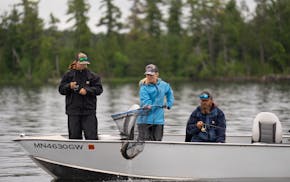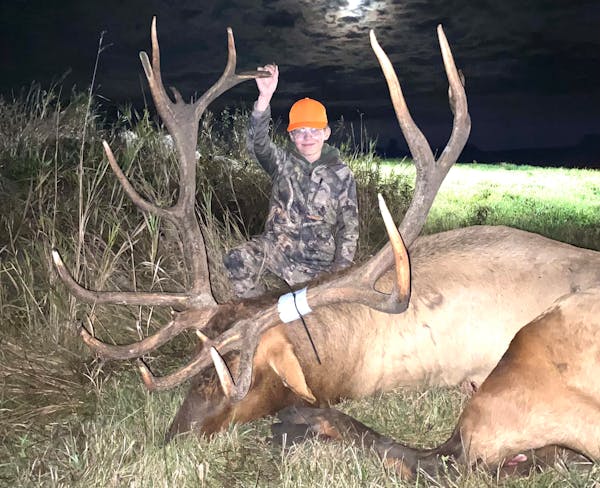Minnesota pheasant hunters, some 70,000 of whom will be afield next Saturday when the state's 2023 ringneck season opens with bright prospects, especially in the state's southwest and western regions, are fortunate, indeed.
In Britain, where public land is at a premium, wingshots who target pheasants pay thousands of dollars a day for the privilege, and at a shoot's end might be awarded a brace of ringnecks by an estate owner, meaning just two birds.
Similar prices often are charged in South Dakota to hunt pheasants that in some cases are advertised as wild but are as tame as homing pigeons.
In Minnesota, meanwhile, not only are uplanders blessed with the prospect of hunting pheasants whose genetics haven't been diminished by breeding with pen-reared stock, hunters also have plenty of public land to tromp, with thousands of acres added every year, thanks to passage in 2008 of the Clean Water, Land and Legacy Amendment.
Doubt this?
Check out these numbers:
• Since 2009, leveraging funds from the state's Outdoor Heritage Fund, which was created by the Legacy Amendment, Pheasants Forever (PF), including members of its 73 Minnesota chapters, has added about 45,000 acres of wildlife management and federal waterfowl production lands in Minnesota's pheasant range.
• During the same period, Ducks Unlimited (DU) has converted to public ownership 6,200 acres of wetlands and shallow lakes; properties that in virtually all cases are surrounded by uplands used by pheasants and other birds, including dickcissels, bobolinks, meadowlarks and many other nongame species. (A note here: Neither PF nor DU owns these lands except for short periods. Their role is to prospect and acquire the properties according to specific, science-based habitat criteria and restore them as needed before transferring them to the Department of Natural Resources or to the U.S. Fish and Wildlife Service.)
• Thousands of additional public acres of wildlife habitat also have been purchased using Outdoor Heritage Funds by the Nature Conservancy, the Trust for Public Land and other entities, including county governments.
• These mostly permanent habitat lands are in addition to the more than 30,000 acres of Minnesota Walk-in Access private properties open to hunting via a DNR program.
Bringing pheasants back
Pheasants have struggled in Minnesota during the past half-century, falling dramatically from the state's peak harvest of 1.56 million roosters in 1958.
The bird's decline has been accelerated in recent years by the loss of federal Conservation Reserve Program (CRP) lands in Minnesota since their 2007 peak of 1.83 million acres. That year the state's nearly 120,000 hunters killed 655,000 roosters, a number that by 2016, when Minnesota CRP acres had fallen by about half, yielded a pheasant harvest of only 196,000 birds to about 60,000 hunters.
Bad luck, or perhaps weather vagaries tied to climate change, also has hurt Minnesota pheasants. Wet and cool conditions that prevailed during recent spring and early summer nesting and hatching seasons (this past spring being an exception) have undercut pheasants' chances to rebuild their numbers through recruitment.
For these reasons and others, Minnesota pheasant hunting is likely to waver between so-so and quite good for the indefinite future.
That said, I believe that, over time, a significant Minnesota ringneck population rebound is not only possible but likely.
Winter survival, recruitment will improve
Here's why:
• Recent habitat-acre purchases in the state's pheasant range, such as those noted here, will support improved pheasant winter survival and recruitment. Moreover, these habitat additions will continue at least for the next 10 years and likely beyond, with the public's expected renewal of the Legacy Amendment when it sunsets in 2033.
• Assuming at least some climate-change predictions come to pass, Minnesota pheasants will benefit from an expanded range, as well as shorter, less severe winters and, especially, warmer, drier nesting conditions.
• Continued improvements in farming technologies and methods, including the increased use of artificial intelligence, and the likely development, in time, of crop alternatives to corn and soybeans that are friendlier to the environment (especially to ground and surface water, as well as wildlife) will occur. Profit motive and public demand will drive these, perhaps equally.
• Increased demand by consumers for food whose production doesn't harm the environment will encourage the nation's nascent farm-to-market movement. This necessarily will replace some of the state's row crops with livestock-supporting pastures, benefiting both water and wildlife.
• The existence today of a consortium of wildlife groups, including PF and DU, ensures as never before that framers of federal and state farm legislation and policies must consider land, water and wildlife conservation.
Minnesota's farmland landscape likely will never resemble its past. In 1940, for example, the state had nearly 8 million acres in pasture, a figure that by the 1980s had declined to 3.2 million acres.
Nor will the number of habitat acres in the state's pheasant range reach the critical mass necessary anytime soon to produce bumper crops of birds and other wildlife. Public wildlife properties, for example, represent only about 3% of all lands in most counties of the state's pheasant range, explaining not only the counties' biodiversity challenges but the reason, especially, why many of its surface and subsurface waters remain polluted.
Yet the pheasant's future remains bright, thanks, yes, to the bird's hardiness and resiliency but also to the countless contributions of time and treasure by Minnesota pheasant and waterfowl hunters.
Without them, the state's 1,500 wildlife management areas wouldn't exist. Nor would its more than 300,000 acres of federal waterfowl production areas.
Nor would the Legacy Amendment have been approved by voters.
One reward among many for these efforts will be realized Oct. 14: Beneath expected steel-gray skies, with temperatures forecast to range between 40 and 54 degrees, bevies of English setters, Labrador retrievers, springer spaniels and other canine breeds will be loosed from their crates, and near towns with names like Wheaton, Donnelly and Canby, autumn rituals that include long walks with occasional flushes of the world's most beautiful game bird will be renewed.
And renewed again, and again, as often as possible, until the season ends Jan. 1.
Anderson: He paddled solo into the BWCA and didn't come back

Anderson: In early June, Minnesota fish are begging to be caught. Won't you help?


